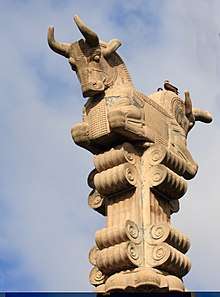Khiva
Khiva (Uzbek: Xiva/Хива, خىۋا; Persian: خیوه, Xīveh; alternative or historical names include Kheeva, Khorasam, Khoresm, Khwarezm, Khwarizm, Khwarazm, Chorezm, Arabic: خوارزم and Persian: خوارزم) is a city of approximately 90,000 people located in Xorazm Region, Uzbekistan. According to archaeological data, the city was established around 1500 years ago.[1] It is the former capital of Khwarezmia and the Khanate of Khiva. Itchan Kala in Khiva was the first site in Uzbekistan to be inscribed in the World Heritage List (1991). The astronomer, historian and polymath, Al-Biruni[2] (973-1048 CE) was born in either Khiva or the nearby city of Kath.
Khiva Xiva / Хива | |
|---|---|
.jpg)   .jpg) _(5596932909).jpg) Clockwise from top Itchan Kala, Alla Kouli Khan Madrasa, Pakhlavan Makhmoud Mausoleum, Islam Hoja Minaret, Muhammad Amin Khan Madrasa and Kalta Minor | |
 Khiva Location in Uzbekistan | |
| Coordinates: 41°23′N 60°22′E | |
| Country | |
| Region | Xorazm Region |
| Population (2017) | |
| • Total | 89 500 |
Etymology
The origin of the name Khiva is unknown, but many contradictory stories have been told to explain it.
A traditional story attributes the name to one of the sons of Prophet Noah(AS): "It is said that Shem(AS) [from whence the word Semitic is derived], after the flood, he found himself wandering in the desert alone. Having fallen asleep, he dreamt of 300 burning torches. On waking up, he was pleased with this omen, he founded the city with outlines in the form of a ship mapped out according to the placement of the torches, about which he had dreamt. Then Sim dug the 'Kheyvak' well, the water from which had a surprising taste. It is possible to see this well in Ichan-Kala (an internal town of Khiva City) even today."[3]
Another story relates that travellers passing through the city, upon drinking the excellent water, would exclaim "Khey vakh!" ("What a pleasure!") and hence the city became known as Kheyvakh, whence Khiva.
A third proposal is that the name comes from the word Khwarezm, altered by borrowing into Turkic as Khivarezem, then shortened to Khiva.
History

In the early part of its history, the inhabitants of the area came from Iranian stock and spoke an Eastern Iranian language called Khwarezmian. Turks replaced the Iranian ruling-class in the 10th century A.D., and the region gradually turned into an area with a majority of Turkic speakers.
The earliest records of the city of Khiva appear in Muslim travel accounts from the 10th century, although archaeological evidence indicates habitation in the 6th century.[4] By the early 17th century, Khiva had become the capital of the Khanate of Khiva, ruled by a branch of the Astrakhans, a Genghisid dynasty.
In the 17th century Khiva began to develop as a slave market. During the first half of the 19th century, around one million Persians and an unknown number of Russians, were enslaved there before being sold. A large part of them were involved in the construction of buildings in the walled Ichan-Kala.[4]
Campaigns
In the course of the Russian conquest of Central Asia, in 1873 the Russian General Konstantin von Kaufman launched an attack on the city of Khiva, which fell on 28 May 1873. Although the Russian Empire now controlled the Khanate, it allowed Khiva to remain as a nominally quasi-independent protectorate.
Following the Bolshevik seizure of power in Russia after the October Revolution of 1917, a short-lived (1920-1925) Khorezm People's Soviet Republic formed out of the territory of the old Khanate of Khiva before its incorporation into the USSR in 1925. The city of Khiva became part of the Uzbek Soviet Socialist Republic.
Sights
_(5586448125).jpg)
Khiva is split into two parts. The outer town, called Dichan Kala, was formerly protected by a wall with 11 gates. The inner town, or Itchan Kala, is encircled by brick walls, whose foundations are believed to have been laid in the 10th century. Present-day crenellated walls date back to the late 17th century and attain the height of 10 meters.
Kalta Minor, the large blue tower in the central city square, was supposed to be a minaret, but the Khan died and the succeeding Khan did not complete it.
The old town retains more than 50 historic monuments and 250 old houses, mostly dating from the 18th or the 19th centuries. Djuma Mosque, for instance, was established in the 10th century and rebuilt in 1788–89, although its celebrated hypostyle hall still retains 112 columns taken from ancient structures.
Sister cities
See also
- Al-Khwarizmi
- Trolleybuses in Urgench
References
- В. А. Булатова, И. И. Ноткин, Архитектурные памятники Хивы. (Путеводитель), Ташкент, 1972; Хива. (Архитектура. Фотоальбом), Л., 1973; Г. Пугаченкова, Термез, Шахрисябз, Хива, (М„ 1976).
- Patrologia Orientalis Tom. Decimus, p.291 https://archive.org/details/patrologiaorient10pariuoft
- Nashriyoti, Davr (2012). Khiva: The City and the Legends. Tashkent, Uzbekistan: DAVR NASHRIYOTI LLC. p. 2. ISBN 9789943339262.
- "Khiva". Encyclopædia Britannica. May 16, 2018. Retrieved June 20, 2020.
Publications
- Campaigning on the Oxus, and the Fall of Khiva, MacGahan, (London, 1874).
- A Ride to Khiva, Frederick Burnaby, (OUP, 1997. First published 1876).
- Russian Central Asia, Lansdell, (London, 1885).
- A travers l'Asie Centrale, Moser, (Paris, 1886).
- Russia against India, Colquhoun, (New York, 1900).
- Khiva, in Russian, S. Goulichambaroff, (Askhabad, 1913).
- A Carpet Ride to Khiva, C. A. Alexander, (London, 2010).
.jpg)
.jpg)
